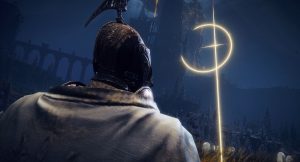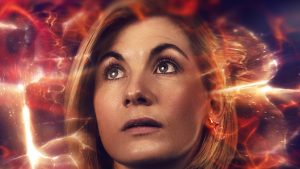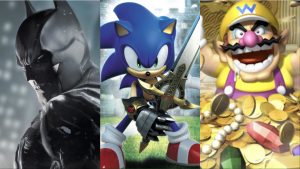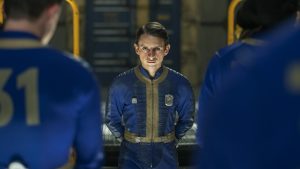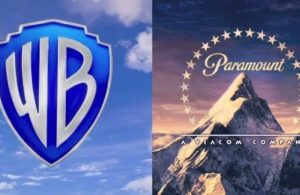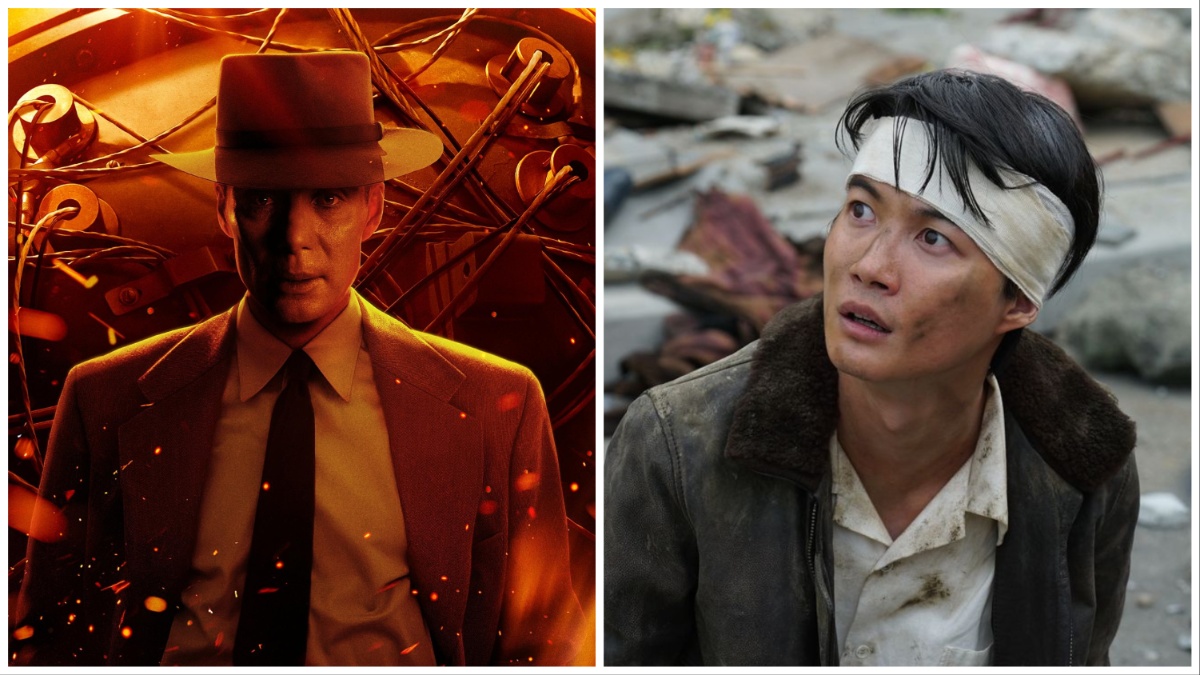
This article contains mild Oppenheimer and Godzilla Minus One spoilers.
The most terrifying sequence in Christopher Nolan’s Oppenheimer is one that never occurred—at least anywhere beyond J. Robert Oppenheimer’s own mind. Mere days after the U.S. government dropped two nuclear bombs on the Japanese cities of Hiroshima and Nagasaki, the scientist who would later be referred to as “the Father of the Atomic Bomb” stands before a cheering crowd inside a Los Alamos gymnasium. Before these giddy revelers, Oppenheimer (played as a man hollowed out by Cillian Murphy) indulges in a bit of flag waving, and a bit of gloating. He tells the victors that he bets the Japanese didn’t like being thrust into a nuclear holocaust!
The words practically choke in Oppenheimer’s mouth; even at this early juncture, where he can only guess at the sheer magnitude of death and carnage inflicted by the bombs, he knows in his bones something monstrous has occurred. And he sees it in the faces of a crowd that’s largely oblivious to how much the world has changed. He even imagines it is they, as opposed to the faceless citizens of Japan we never see in Oppenheimer, who have been engulfed in the blinding light of a nuclear blast, leaving one young girl’s skin melting from her face, and another soul so vaporized that he resembles a pile of soot beneath Oppie’s shoe.
This is the closest Nolan comes to hinting at the incomprehensible horror of nuclear fallout, and how it was visited at a monumental scale on Hiroshima and Nagasaki. As the film is told entirely from the perspectives of either Oppenheimer or his envious bureaucratic rival, Lewis Strauss (Robert Downey Jr.), we never once glimpse the point-of-view of the actual Japanese who endured the fruits of Oppenheimer’s labors—or those who survived it, only to deal with the physical and psychic scars it left behind. Fairly or not, Nolan’s deliberate omission has been criticized by some, including Spike Lee, for not providing the whole picture.
How strange, yet apt, it is then that another mass entertainment would inadvertently provide the counterpoint to Oppenheimer, and even find unlikely shared points of agreement. Look out, here comes Godzilla.
A Return of the Original Godzilla
Proving that truly great ideas can live forever, Toho Studios’ 33rd Godzilla movie is probably the best they’ve ever made. It’s certainly the first to come closest at recapturing and expanding on the nuclear despair which loomed over the original 1954 Godzilla. Written and directed by respected Japanese auteur Takashi Yamazaki, Godzilla Minus One is a ferocious beast of a film, and for more reasons than just its terrifying take on the fire-breathing lizard.
Although he is definitely that too. Gone is the sometimes cuddly and kid-friendly Big G of the later Showa era of Toho films; likewise the benevolent god of the recent American “MonsterVerse” films is nowhere to be found. If Godzilla Minus One’s titular monster is any kind of deity, it is of a demonic and Lovecraftian variety. It’s unknowable and irredeemable, and one of the few versions of the kaiju to have the cancerous lesions left by radiation poisoning used in the original 1954 film. He isn’t sickly though. He is wrath made scaly flesh. Yamazaki uses that to spectacular effect, too, particularly in sequences inspired by Jaws where a group of Japanese sailors in a rickety wooden boat wind up fleeing for their lives across the Pacific as Godzilla’s gaping mouth swims ever closer.
Godzilla Minus One is a visceral cinematic experience. Yet unlike almost every other Godzilla or giant monster movie, this quality has as much to do with the human characters as it does with the mighty beasts they fear. For just as much as Oppenheimer, Godzilla Minus One is about the scars left by the Second World War, only now it’s entirely from the perspective of those who were forced to look up and bear witness to the totality of annihilation.
Boldly beginning during the final days of World War II, Godzilla Minus One introduces the viewer to Koichi Shikishima (Ryunosuke Kamiki) as its hero. He is a kamikaze pilot who failed to commit suicide by flying his plane into the side of an American battleship. And he did not falter out of a sense of moral objection or due to some mechanical issue. It was simply a fear of death, at its purest and most primal, that caused him to pretend his plane was faulty, bringing him to the island of Odo instead. There he gets a second opportunity to embrace death when he is asked to use his plane to battle Godzilla during the reptile’s first emergence from the sea; Shikishima cannot even look the creature in the eye as it slaughters an entire Japanese garrison.
Shame is thus what Koichi carries home from the war and what he has to live with upon discovering his entire neighborhood in Tokyo was demolished by American air raids. His parents are dead. His friends are dead. Everyone is dead. Except for him… and eventually a makeshift family he adopts via the young woman Noriko (Minami Hamabe) and a baby she calls Akiko. Like Koichi, they’re orphans with nowhere else to go after the war, so he lets them stay in the ruins of his home, even as he resists being called a father or husband. Such tokens of affection would mean he is a man who deserves happiness.
What Yamazaki achieves is extraordinary for not only a Godzilla movie, but almost any blockbuster. The filmmaker is able to craft an intimate character drama about an adopted family surviving during a postwar reconstruction era. He’s created a character drama as compelling as the monster attack scenes. He also is perhaps the first filmmaker to expand on the themes of the original Godzilla and, in doing so, creates Oppenheimer’s true soulmate.
Minus One or Oppenheimer’s Legacy Sequel?
The original Godzilla movie is a classic of Japanese cinema for obvious reasons. In addition to reinventing the giant monster (or kaiju) genre for an Eastern sensibility, it also created a heavy parable for the fear of both nuclear annihilation and war in general. Godzilla’s nuclear breath speaks for itself, but his habitual nightly raids on Tokyo more closely resemble the firebombing of the city ordered by Maj. Gen. Curtis LeMay, a man who later said, “If we’d lost the war, we’d all have been prosecuted as war criminals.”
Godzilla Minus One takes two steps back from the original Godzilla’s metaphor and lives in the reality of what the ’54 film only implied. Koichi and audiences experience firsthand that horror when the alleged war hero returns home only to find rubble and ruin. Later while discussing anything, from sea mines to mutated dinosaurs, Koichi and his drinking buddies gather in tented bars with no doors. Like the real-life “piss alley” that still stands in Tokyo to this day, this is a literal hole in the wall where veterans gather to drink in a back alley. In every scene, Koichi lives with the fallout of the war that Oppenheimer could barely stand to think about in that gymnasium, and Koichi hasn’t even seen its full nuclear impact firsthand. That only comes once Godzilla arrives in Tokyo.
In that apocalyptic sequence, the monster’s fire breath not so subtly resembles a mushroom cloud—“a great column of fire” as Robert speculated it would look like during one scene in Oppenheimer. In Godzilla Minus One, the monster is restored to the nuclear war traumas that originally inspired the character’s creation. In the film’s most haunting scene, Koichi stands in the graveyard that was only minutes earlier a thriving neighborhood. He screams into the void as ash of those who were just vaporized float into his hair.
Godzilla Minus One envisions the aftermath that Oppenheimer intentionally avoided, and stays with the people who must endure it the morning after.
Just Who Is the Real Monster…
One might be tempted to read this new Godzilla as the personification of the American war machine. Like the U.S., Minus One‘s Godzilla arrives above Tokyo unannounced and leaves flame and anguish in his wake. But that simple of a reading would be as misguided as assuming J. Robert Oppenheimer was proud of his invention. To be sure, Godzilla Minus One is acidly skeptical of the American impact on Japan. Also like the original film, nuclear testing on the island of Bikini Atoll in 1946 is credited as mutating Godzilla into something even more monstrous. (There is even a bit of amusing if unlikely historical fiction wherein after Godzilla is detected, the American Commander of the Pacific Fleet, Douglas MacArthur, orders Japan to dust off a few of their decommissioned battleships and handle the big lizard themselves.) Yet it is in Koichi’s full journey that we come to understand Minus One’s cynicism even almost matches Oppenheimer’s final confession to Einstein in the Nolan film.
When we meet Koichi at the beginning of Minus One, he is a kamikaze pilot who wants to live. Over the course of the story, he develops a death wish out of a sense of shame, a sense of duty, and finally a sense of revenge. By the end of the film, he plans to drive his plane right down the throat of Godzilla in a mad effort to kill the monster by way of seppuku. The real tension of the climax thus becomes less about Godzilla and more about whether Komichi will go through with it.
Koichi’s greatest obstacle is likewise not a dinosaur, but a former naval engineer named Kenji Noda (Hidetaka Yoshioka), who befriended Koichi’s family in the postwar years and is adamant they can discover a way to defeat Godzilla without anymore soldiers, sailors, or pilots sacrificing their lives. He implicitly indicts their government for failing its citizens during the war, noting they built “planes without ejection seats” as one of the many signs of how the government wasted human life. Koichi’s determination to die by kamikaze attack, meanwhile, is a remnant of the same wartime mindset that caused the Japanese government to bomb Pearl Harbor (not to mention commit many other war crimes of their own); Kenji and Koichi’s competing solutions to the Godzilla problem represent a nation grappling with second-guessing its past and being unable to choose a future.
That each tries to take matters into his own hands, absent any centralized authority, also betrays a deep cynicism about the imperial government after the war. After all, in the film the Japanese government knows Godzilla is coming toward Tokyo but does not warn its citizens because of fear of a panic. But then this was the same government that was determined to fight an Allied land invasion even after the war was lost. Half of the high command even attempted to prevent the emperor’s surrender by way of a mini-coup despite the mass death at Hiroshima and Nagasaki.
Godzilla Minus One is ultimately grossly skeptical of all governments and all war machines that feed men and civilians alike into the grinder. While the protagonist of Oppenheimer never once expresses regret for what happened to Hiroshima and Nagasaki (aloud at any rate), he likewise becomes evermore cynical about his own government. He witnesses firsthand what he perceives as shortsighted hubris by President Harry Truman (Gary Oldman), who boasts that the Soviets will never build a nuclear bomb. Oppenheimer also comes to regard the dropping of any nuclear bombs on Japan as unnecessary to win the war without a land invasion (the facts are a lot more ambiguous on that point).
Finally, Oppenheimer is effectively retired and disgraced by his own government; sent out to sit at the duck pond with Einstein for the rest of his years. This is because Oppenheimer resisted the desire to build an even deadlier “super” hydrogen bomb… the kind that would eventually be tested in the Pacific and inspire the concept of Godzilla.
While one is a grimly accurate masterclass in cinematic biography and the other is a fantastical monster movie, Oppenheimer and Godzilla Minus One arrive at the same conclusion about the same war from two different sides: pure horror and intense regret about the choices that were made. It’s a horror so total and undeniable that neither film can even directly look at it. Oppenheimer can only dare imagine what its subject might admit to himself in his darkest moments; Godzilla Minus One is still, ultimately, a fantasy. It uses parable and metaphor to even begin grappling with the consequences of nuclear annihilation. Together, their perspectives are two sides of the same war fog.
Oppenheimer might have been one half of the biggest double feature in movie history this past summer, but its true counterpoint is big, scaly, and going on a colossal tear.
The post Godzilla Minus One Is the Oppenheimer Sequel You Didn’t Know You Needed appeared first on Den of Geek.
